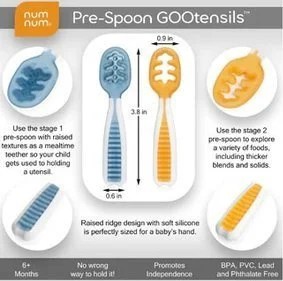My kids are well past playing with food and utensils, but I remember the constant clean-up of those times. We used to joke about lining the kitchen with plastic wrap.
Which brings us to the “pre-spoon” – something you use to train your children before they graduate to a real spoon. Numnum’s has a well-designed site selling their pre-spoon (https://numnumbaby.us/pages/pre-spoon-gootensils) using the slogan “When it’s too soon to spoon, it’s the perfect time for NumNum.”

What it was not the perfect time for was getting their patent through the USPTO without improper rejections. Appeal 2022-001343. Application 15/294,414.
Claim 1 is reproduced below. The Office rejected claim 1 based on a combination of three references.
1. A utensil comprising:
a rounded handle end; and
a food end consisting of an exterior edge and a non-concave surface having interior extending arms,
wherein the utensil is approximately four inches long,
wherein the food end is to enter into a person’s mouth, and
wherein the arms in combination with portions of the non-concave surface together define a food retaining edge, wherein the food retaining edge defines a hole.
The applicant here strategically prepared for the appeal by not only having various arguments against the combination, but also by including declaration evidence to support commercial success. As is often the case with “simple” mechanical inventions, the Office can successfully string together a combination and utilize various doctrines related to intended use and the like to reject the claims. However, examiners often discount evidence of commercial success as lacking the required ‘nexus’ (between the claimed invention and the commercial success). Here, Numnum’s declaration hit all the necessary points to tip the PTAB from sustaining to reversing the rejection.
Specifically, the applicant tried seven arguments against the combination, from hindsight to lacking an expectation of success and everything in between. The PTAB swatted each one by the wayside. But when the issue of secondary considerations came up, the PTAB found that the examiner erred.
Some relevant aspects of the declaration in this case (linked here) are how it shows that the commercial product embodies the claimed invention. Specifically, the declaration shows, with images of the commercial product, how the commercial products “are essentially the claimed invention.” Further, the declaration explained how the commercial products contain no additional unclaimed elements that contribute to the commercial success of the products, as supported by the pictorial comparison. The declaration went on to link the commercial success to the claimed features by showing the applicant was able to charge nearly double the price of most typical early utensils and that there was no impact from sales/marketing, while also including customer reviews praising function according to the claimed structure (e.g., retaining yogurt). Finally, the declaration laid out sales data and linking that growth to the product by explaining that there could have been more but for production limitations.
This case represents a good example of how to establish commercial success for applicants developing new products in a small business where patent protection can be critical. Just because you cannot successfully spoon feed your commercial success evidence to the examiner does not mean you do not have potential to convince the PTAB. But, there are many pitfalls to relying on commercial success so be careful with the declaration and supporting evidence to avoid leaving a gap that allows the PTAB to affirm.

Leave a comment